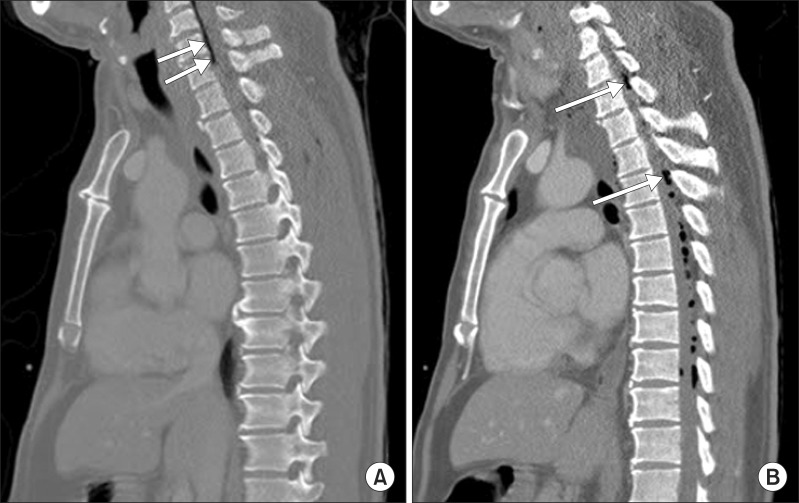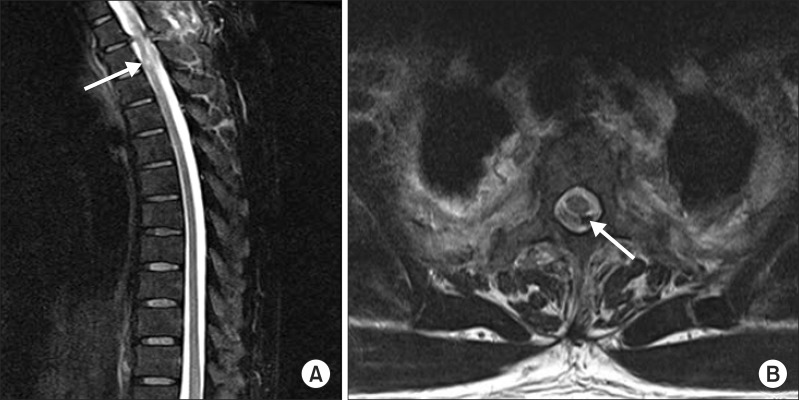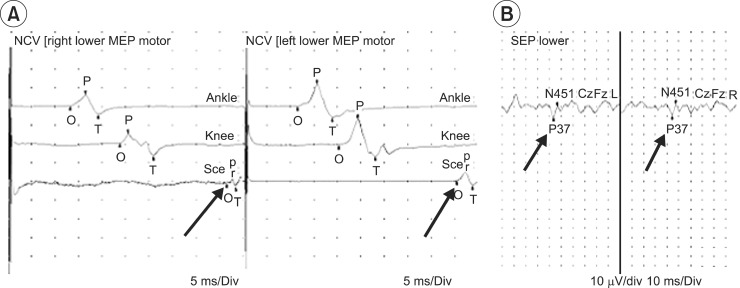Ann Rehabil Med.
2014 Jun;38(3):410-414. 10.5535/arm.2014.38.3.410.
Atypical Traumatic Pneumorrhachis Accompanied by Paraparesis
- Affiliations
-
- 1Department of Rehabilitation Medicine, Chosun University Hospital, Gwangju, Korea. dwchoi81@naver.com
- KMID: 2165762
- DOI: http://doi.org/10.5535/arm.2014.38.3.410
Abstract
- Pneumorrhachis, caused by intraspinal air, is an exceptional but important radiographic finding that is accompanied by different etiologies. Pneumorrhachis, by itself, is usually asymptomatic and gets reabsorbed spontaneously. Therefore, the patients with pneumorrhachis are mostly managed conservatively. We encountered a unique case of atypical traumatic pneumorrhachis accompanied by paraparesis.
Keyword
MeSH Terms
Figure
Reference
-
2. Oertel MF, Korinth MC, Reinges MH, Krings T, Terbeck S, Gilsbach JM. Pathogenesis, diagnosis and management of pneumorrhachis. Eur Spine J. 2006; 15(Suppl 5):636–643. PMID: 16835735.
Article3. Uemura K, Behr R, Roosen K. Symptomatic intraspinal air entrapment. Br J Neurosurg. 2000; 14:154–156. PMID: 10889894.4. Krishnam , Mallick A. Air in the epidural space leading to a neurological deficit. Anaesthesia. 2003; 58:292–293. PMID: 12603477.
Article5. Ristagno RL, Hiratzka LF, Rost RC Jr. An unusual case of pneumorrhachis following resection of lung carcinoma. Chest. 2002; 121:1712–1714. PMID: 12006470.
Article6. Kirzner H, Oh YK, Lee SH. Intraspinal air: a CT finding of epidural abscess. AJR Am J Roentgenol. 1988; 151:1217–1218. PMID: 3263775.
Article7. Newbold RG, Wiener MD, Vogler JB 3rd, Martinez S. Traumatic pneumorrhachis. AJR Am J Roentgenol. 1987; 148:615–616. PMID: 3492895.
Article8. Burn JM, Guyer PB, Langdon L. The spread of solutions injected into the epidural space: a study using epidurograms in patients with the lumbosciatic syndrome. Br J Anaesth. 1973; 45:338–345. PMID: 4267504.
Article9. Khodadadyan C, Hoffmann R, Neumann K, Sudkamp NP. Unrecognized pneumothorax as a cause of intraspinal air. Spine (Phila Pa 1976). 1995; 20:838–840. PMID: 7701399.
Article10. Paik NC, Lim CS, Jang HS. Cauda equina syndrome caused by epidural pneumorrhachis: treatment with percutaneous computed tomography-guided translaminar trephination. Spine (Phila Pa 1976). 2013; 38:E440–E443. PMID: 23324943.
- Full Text Links
- Actions
-
Cited
- CITED
-
- Close
- Share
- Similar articles
-
- Traumatic Pneumorrhachis
- A Case of Pneumorrhachis Associated with Spontaneous Pneumomediastinum and Subcutaneous Emphysema
- Symptomatic Epidural Pneumorrhachis : A Rare Entity
- Pneumorrhachis and Paraspinal Air with Vacuum Disc: Case Report and Literature Review
- A Case of Broncho-Paraspinal Fistula Induced by Metallic Devices: Delayed Complication of Thoracic Spinal Surgery




